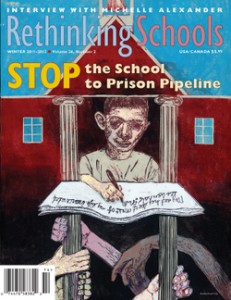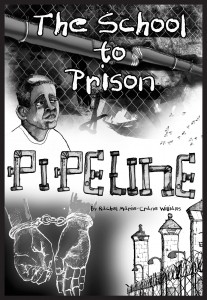From New America Media:
Former NAM managing editor Annette Fuentes is the author of a new book, Lockdown High: When the Schoolhouse Becomes the Jail House, published by Verso. The book explores the reasons zero-tolerance policies have grown and investigates the impact those policies are having on students. She was interviewed by NAM associate editor Jacob Simas.
JS: We’ve witnessed a trend over the last 20 years or so, of schools embracing security and punishment as a means to control student behavior. Would it be safe to assume, then, that our schools are not as safe as they used to be?
AF: It would be very inaccurate [to say that]. Schools today are among the safest places for children to be, and that includes their homes and their neighborhoods. We know, the experts know, that the level of violence in our public schools is among the lowest level it’s been in in about 20 years. School violence peaked in the early ‘90s. Data from the National Center on School Violence… show clearly that incidents of violence in schools have been going down. And this parallels crime in general, in the wider society. So schools are in almost all cases the safest places for kids to be. That doesn’t mean that there are not incidents of school violence, but they have been so blown out of proportion that most people walk around thinking that another Columbine is just around the corner.
JS: So why the hysteria around violence? Now, you mentioned Columbine, but certainly the hysteria is due to more than just one isolated incident.
AF: Columbine happened in 1999, but in fact there had been a handful — maybe four or five – of very high-profile school shootings in the years preceding Columbine. There was one in Paducah, Kentucky; a student who shot classmates at a prayer group up in Springfield, Orgeon; a young man who shot and killed his parents and then went to school with his gun and shot at folks. There were several that were very high profile. So people already were kind of primed for school violence.
Now, remember, these shootings were very high profile; they claimed multiple victims. But compared to how many kids are killed every day in acts of violence in their own homes, in their own neighborhoods, it just doesn’t even compare. But these were crimes that had shocked people, and that made it appear that schools were violent. And it fit with the narrative of violent children, violent schools that had been building since the 1980s.
You know, we’ve been a society afraid of crime since, really, the Reagan administration and perhaps before. But the war on drugs led to the war on kids, and the increasing prison-like conditions for juveniles in general. So we started cracking down on kids in schools and it’s just led to a whole raft of policies and practices that have made schools more and more like prisons.
My book talks about everything, from the increased presence of police, the increased use of drug-sniffing dogs, of drug testing in schools — and I’m not even talking urban schools, I’m talking about schools in suburban New Jersey or suburban Oregon — where parents are afraid that their kids are doing drugs and are out of control. We are clamping down on kids with other high tech security and surveillance equipment at a time of scarce school resources. School districts are spending money on the surveillance hardware of the prison state.
JS: Many have criticized zero tolerance policies for creating a “school-to-prison pipeline.” Does that argument have any teeth, and if so, could you paint us a picture of how such a scenario might play out?
AF: It’s really a very, very ugly scenario. But we know, and the education and legal researchers who have been looking at this issue for two, maybe three decades have found, that zero tolerance policies that put kids at risk of suspension, and then lead to kids dropping out, those (in turn) put them at risk of falling into the prison pipeline.
So we know that high percentages of black and Latino kids have high rates of drop out from schools, and we know that a high percentage of the prison population is comprised of black and Latino men in particular, although young women are increasingly in that scenario. But researchers like Russell Skiba — who was one of the first to do research on suspensions and look at the racial component of it — they’ve shown how increasing the number of suspensions increases the risks of the most vulnerable students to being pushed out of school.
Now, the other part of this equation is that schools and teachers are under incredible pressure, especially with No Child Left Behind (NCLB) — which was former President George W. Bush’s signature education bill. What NCLB did was to put incredible pressure to achieve unrealistic levels of achievement in English and math from students who were starting at a very low level, and were expected each year to increase their English and math skills really unrealistically.
Teachers and schools were not given the resources to make these changes to increase the achievement levels, and so for a lot of teachers — and I heard this time and again during the course of my two years of reporting — teachers were under pressure to get the lowest-achieving students out of their classrooms. You get rid of the lower achievers, and you automatically have a class whose collective achievement level is raised. So those kids who are the most challenged, the lowest achievers, are those who need the most resources. But in resource-starved classrooms, they’re not getting it. In some cases, sadly, it’s easier to just suspend them because they’re trouble and because the teacher doesn’t have the wherewithal to deal with that student one-on-one. And unfortunately, in a time of budget cuts all over the country, the fear is that this is just being worsened because suspension becomes a quick fix for kids who are the most challenging to deal with.
Read the rest here.


